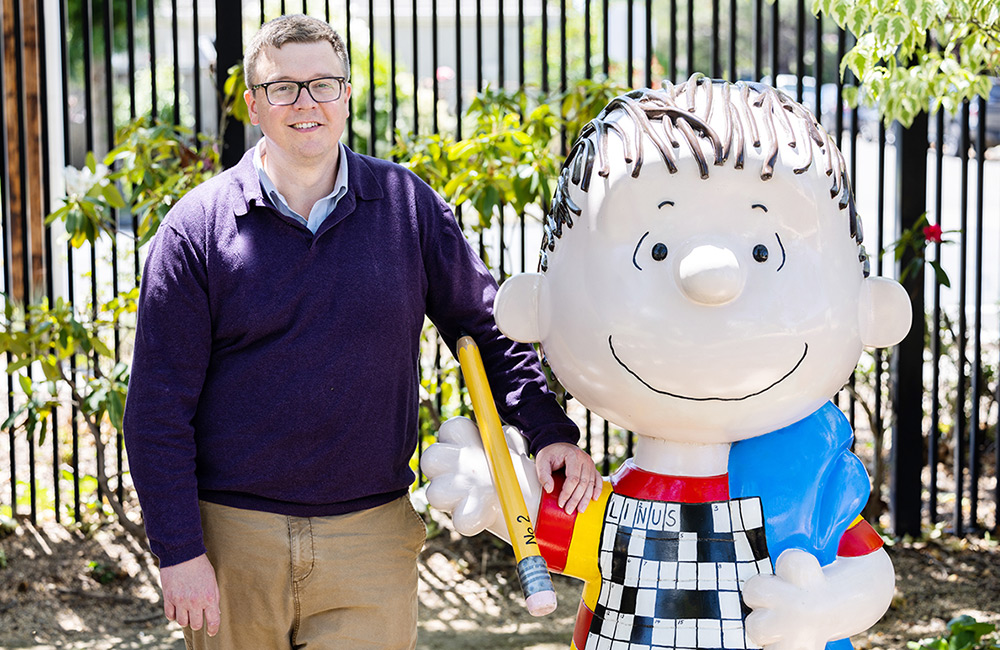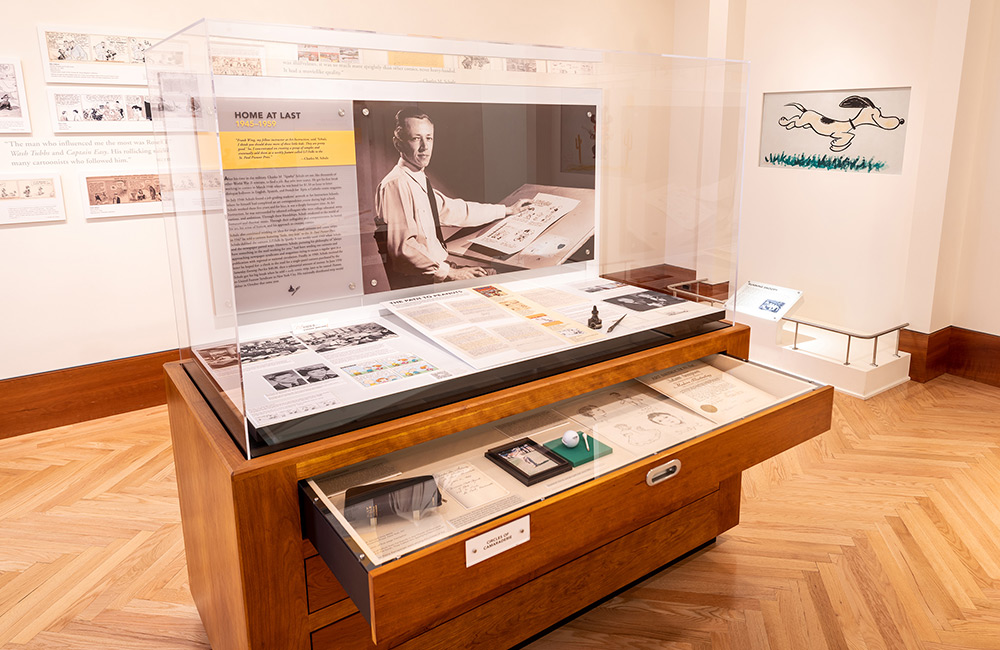What is your role as curator of the Charles M. Schulz Museum?
I oversee the care, growth, and interpretation of the collections at the Schulz Museum in Santa Rosa, California.
With six exhibitions each year at the Schulz Museum, and two in Tokyo at our satellite museum Snoopy Museum Tokyo, I have eight exhibitions in various stages of development at any given time. So, day-today, I’m doing a lot of writing and researching — and book writing! Charles M. Schulz: The Life of the Peanuts Creator in 100 Objects is available now.
This means I have the opportunity to work closely with Jean Schulz, the widow of Charles Schulz, and lots of fans, collectors, and even other cartoonists. As a historian, it’s really special to have a living subject like Mrs. Schulz, who is so accessible and open about their life and experience and happy to be involved. Fortunately, I also have an incredible team of people I do my best to support, providing the day-to-day care of the collections and archives and designing and making arrangements for all our exhibitions, both in-house and our travelling exhibitions program.
Museums, libraries, and other venues can borrow exhibitions from us, as well. Every so often, they invite me to come speak, too, so I get to visit other museums and meet passionate people to share the story of Charles Schulz and Peanuts.

Peanuts premiered in 1950 but had roots in Schulz’s 1947 comic titled Li’l Folks. Why do characters imagined over 75 years ago still have such an impact on existing readers and continue to earn new fans?
Li’l Folks is where Charles Schulz refined his drawing and character design style and began finding his voice as a cartoonist and humorist.
When he got his contract for a new comic strip, his syndicate liked the drawing style and humour but asked him to develop recurring characters, which he didn’t really have in Li’l Folks. In reading those first few years of Peanuts strips today, we can see Schulz stretching and growing and becoming the cartoonist he would be. As cartoonist (and Schulz Creative Associates Editor) Alexis E. Fajardo said, “He was learning to cartoon his cartoon.”
Schulz also learned to trust the process of evolution and natural development. His characters grew and changed, similarly to how real people change over time. He also constantly connected with his own memories and experiences. In his efforts to write specifically about things that happened to him, he created something universal that captures the reality of small moments — about experiences that nearly all of his readers would understand or could easily imagine being real. He explored themes about friendship, loneliness, conflict, and connection, all of which draw readers in deeper and deeper.

Schulz was ahead of his time in many ways, including the fact that he didn’t shy away from expanding Charlie Brown’s social circle to include more diversity. He introduced characters with different racial backgrounds, family dynamics, schools, interests, and abilities. What inspired him to be more inclusive?
Charles Schulz saw himself as a nobody from nowhere that someone took a chance on. He knew it was a mixture of talent and hard work that helped him become successful, but there was another piece of that puzzle for success: He was granted the opportunity to prove himself. And he always believed that everyone deserved a chance to take their shot; that everyone should have the opportunity to prove themselves and to take part.
He also believed that barriers should be eliminated to help those who have historically not had the same opportunities as others. Whether they were obstacles based on their skin colour or gender or whatever else, he thought everyone should be treated equally. One example is that Schulz would become involved in promoting equality for women’s sports, joining the board of directors of Billie Jean King’s Women’s Sports Foundation in the 1970s, and sponsoring women’s sporting events and mixed-gender events where winners received equal shares of prize money.
This background and these relationships were all important parts of making it clear to him that there were direct actions he could take to help others be included.

In what ways do you see the influence of Charles Schulz expressed in contemporary cartooning?
In 1950, when Peanuts debuted, United Feature Syndicate designed it to be a “space saver” comic strip, which was a new idea. It was a comic strip that could be printed in newspapers in varying widths and layouts. It could be printed anywhere in the newspaper, not just in the comic section.
This is why for nearly 40 years Peanuts daily comic strips, every day but Sunday, appear in four equal panels. This way, it could be printed horizontally or vertically or stacked in a square of two-by-two panels. In this reduced-from-standard format, Schulz developed his deceptively simple style, using masterful penwork and focusing on only using what was necessary to pull off each day’s cartoon. And, in the coming years, newspapers began to shrink their page sizes. Comic strips also needed to shrink, and many looked to the success of Charles Schulz and his style as inspiration for accommodating this smaller size. Even more influential is the fact that Peanuts is funny and well drawn.
Schulz returned again and again to successful storylines and themes like unrequited love and quiet moments of reflection, but also carried forward classic comic-strip tropes and features developed by previous generations of creators to a new generation of readers.

Charles M. Schulz Museum and Research Center is known for its extensive programming. Classes, online programs, school outreach, field trips, festivals, and special exhibits are all hosted alongside the permanent collection. What does 2023 hold for the organization?
Yes, there’s always something going on at the Schulz Museum! Always something new to see, too. We host six exhibitions yearly on a staggered, rotating schedule, so you could come every two months and see new exhibitions!
In 2023, exhibitions include: Kite-Flying Foibles opening in March, Single Panel Peanuts opening in May, Snoopy in Space opening in July, Peanuts School Days opening in September and much more.
You can learn more about everything going on at the Schulz Museum on our website.

Explore Schulz Museum online to learn more about the legacy of Charles Schulz, read Jean Schulz’s blog, and view its calendar of events.







